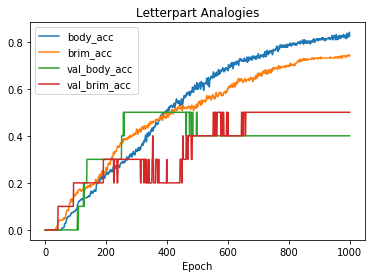3.17. Gridfonts¶
This notebook explores the datasets “gridfonts” and “figure-ground-a” based on Douglas Hofstadter and colleagues Letter Spririt project. See also gridfonts.
This data was used in both Gary McGraw’s and Douglas Blank’s theses to train neural networks. See section 6.3.2 of McGraw’s thesis, and Blank’s thesis Learning to See Analogies: a Connectionist Exploration.
figure-ground-ais composed of letter a’sgridfontis composed of entire alphabets
[1]:
import conx as cx
Using TensorFlow backend.
ConX, version 3.7.5
3.17.1. Letterpart Analogies¶
First, we download and load the figure_ground_a dataset:
[2]:
ds = cx.Dataset.get("figure_ground_a")
[3]:
ds.summary()
_________________________________________________________________
Figure-Ground A:
Patterns Shape Range
=================================================================
inputs (153,) (0, 1)
targets [(153,), (153,)] [(0, 1), (0, 1)]
=================================================================
Total patterns: 229
Training patterns: 229
Testing patterns: 0
_________________________________________________________________
The figure_ground_a database is composed of 229 a’s where:
- input - a 153 integer “picture” of an “a” representing 17 rows and 9 columns
- targets - two 153 pictures, representing the “brim” of the letter a, and the “body”
Let’s display the letters in a graphical manner:
[4]:
def display_letter_parts(letter, brim, body):
print("Letter Brim Body")
for row in range(17):
for col in range(9):
print("." if letter[row * 9 + col] == 0 else "X", end="")
print(" ", end="")
for col in range(9):
print("." if brim[row * 9 + col] == 0 else "X", end="")
print(" ", end="")
for col in range(9):
print("." if body[row * 9 + col] == 0 else "X", end="")
print()
[5]:
display_letter_parts(ds.inputs[0], ds.targets[0][0], ds.targets[0][1])
Letter Brim Body
......... ......... .........
......... ......... .........
......... ......... .........
......... ......... .........
....XXXXX ....X.... ....XXXXX
...XX...X ...X..... ....X...X
..X.X...X ..X...... ....X...X
.X..X...X .X....... ....X...X
X...X...X X........ ....X...X
...X...X. ......... ...X...X.
..X...X.. ......... ..X...X..
.X...X... ......... .X...X...
XXXXX.... ......... XXXXX....
......... ......... .........
......... ......... .........
......... ......... .........
......... ......... .........
Let’s design some networks that attempt to replicate the brim and body given the original gridfont letter.
First, let’s change the format of the dataset input so that we can treat the input as a 2D 17 x 9 image rather than merely a vector of 153 values. We actually make it a 3D shape, the third dimension representing color (which it doesn’t have).
[6]:
ds.inputs.reshape(0, (17, 9, 1))
[7]:
cx.shape(ds.inputs[0])
[7]:
(17, 9, 1)
[8]:
cx.array_to_image(ds.inputs[0], scale=10)
[8]:

[9]:
cx.array_to_image(ds.targets[0][0], scale=10, shape=(17,9))
[9]:

[10]:
cx.array_to_image(ds.targets[0][1], scale=10, shape=(17,9))
[10]:

We can now use a Convolutional Layer to better process the letter “picture”. Notice that we flatten the output of the Convolutional layer to bring the output back into a single dimension.
[11]:
net = cx.Network("Letterpart Analogies")
net.add(cx.Layer("input", (17, 9, 1)))
net.add(cx.Conv2DLayer("conv", 2, (2,2)))
net.add(cx.FlattenLayer("flatten"))
net.add(cx.Layer("hidden", 50, activation="relu"))
net.add(cx.Layer("brim", 153, vshape=(17, 9), activation="sigmoid"))
net.add(cx.Layer("body", 153, vshape=(17, 9), activation="sigmoid"))
net.connect("input", "conv")
net.connect("conv", "flatten")
net.connect("flatten", "hidden")
net.connect("hidden", "brim")
net.connect("hidden", "body")
net.compile(error="mse", optimizer="adam")
We associate the dataset to the network, and save 10 pictures for testing.
[12]:
net.set_dataset(ds)
net.dataset.split(10)
[13]:
net.dashboard()
Now, we are ready to train the network to replicate the letter parts.
[14]:
net.train(1000, accuracy=1.0, tolerance=0.4, batch_size=128, report_rate=100)
========================================================
| Training | Validate | body | brim | val | val
Epochs | Error | Error | acc | acc | body acc | brim acc
------ | --------- | --------- | --------- | --------- | --------- | ---------
# 1000 | 0.00738 | 0.04522 | 0.82648 | 0.73973 | 0.40000 | 0.50000
[15]:
net.plot(".*acc")

[16]:
net.picture()
[16]:
[17]:
results = net.train_one(ds.inputs[8], ds.targets[1])
3.17.2. Gridfonts - leter recognition¶
[18]:
ds = cx.Dataset.get("gridfonts")
[19]:
ds.summary()
_________________________________________________________________
Gridfonts:
Patterns Shape Range
=================================================================
inputs (25, 9) (0.0, 1.0)
targets (25, 9) (0.0, 1.0)
=================================================================
Total patterns: 7462
Training patterns: 7462
Testing patterns: 0
_________________________________________________________________
[20]:
net = cx.Network("Gridfonts")
net.add(cx.Layer("inputs", (25,9)))
net.add(cx.FlattenLayer("flatten"))
net.add(cx.Layer("hiddens", 20, activation="sigmoid"))
net.add(cx.Layer("outputs", (25, 9), activation="relu"))
net.connect()
net.compile(error="mse", optimizer="adam")
[21]:
net.set_dataset(ds)
WARNING: network 'Gridfonts' target bank #0 has a multi-dimensional shape; is this correct?
[22]:
display(net)
output = net.propagate(ds.inputs[26])
print(ds.labels[26])
a
[23]:
def display_letter(letter):
print("Letter")
for row in range(25):
for col in range(9):
print("." if letter[row][col] == 0 else "X", end="")
print()
[24]:
display_letter(ds.inputs[0])
Letter
.........
.........
.........
.........
.........
.........
.........
.........
....XXXXX
...XX...X
..X.X...X
.X..X...X
X...X...X
...X...X.
..X...X..
.X...X...
XXXXX....
.........
.........
.........
.........
.........
.........
.........
.........
[25]:
cx.array_to_image(ds.inputs[0], scale=10)
[25]:

[26]:
cx.array_to_image(ds.targets[0], scale=10)
[26]:

[ ]: